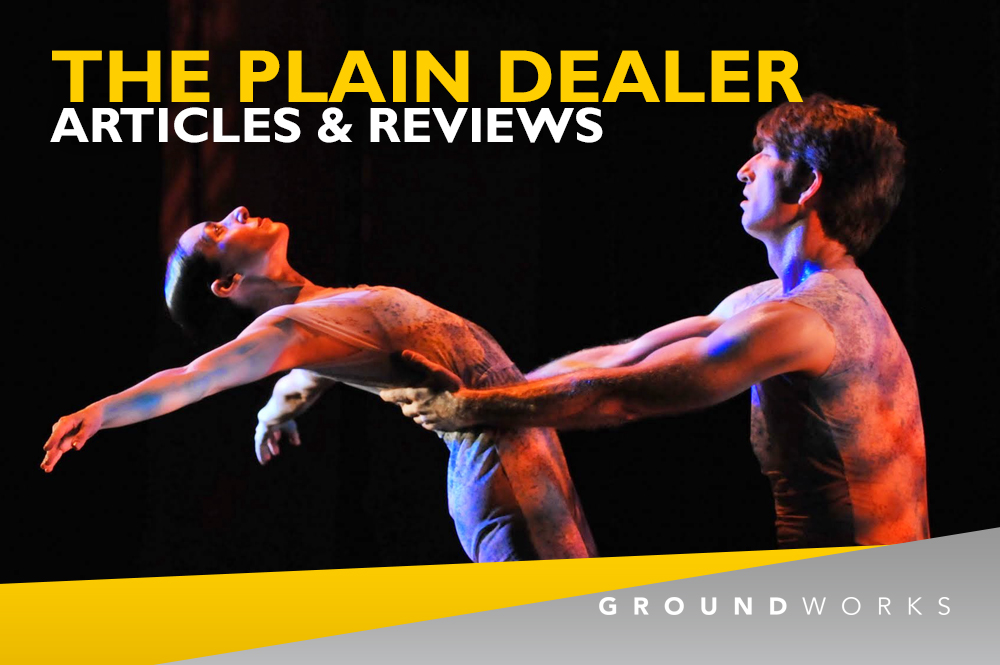Project Description
The Plain Dealer – ChamberFest Cleveland 2014 concludes with fascinating ‘Ghost Opera’ and lively ‘Last Round’ (review)
By Mark Satola, The Plain Dealer
The persistence of the standard concert program model, which in its rudimentary form could be described as “overture, concerto and symphony,” suggests that its viability has not diminished over the course of nearly two centuries, however familiar it has become.How invigorating it is, however, when that format is ingeniously subverted in a number of ways, as was the case Saturday night in Kulas Hall at the Cleveland Institute of Music, for the penultimate concert in this year’s ChamberFest Cleveland.
The concert, titled “Ghost Opera – Past, Present, Future” featured the most adventurous music heard in the series, including a unique collaboration with GroundWorks DanceTheater for Tan Dun’s highly ritualistic “Ghost Opera” for String Quartet and Pipa, with Water, Stones, Paper and Metal.
Lighting (by Dennis Dugan) and theatrical staging played a large role in the proceedings from the beginning of the evening. Percussionists Alex Cohen, Scott Christian and Luke Rinderknecht opened the concert with three disparate pieces that inhabited the world of ritual, including “Amores III” (1936/1943) by John Cage, for tuned woodblocks, “Shi (Food)” (2008) by Brazilian composer Alexandre Lunsqui, and the finale from “Trio per Uno” Op. 27 (1995/1999) by Serbian composer Nebojsa Jovan Zivkovic.
The remarkable gentleness of Cage’s Eastern-influenced work was aptly captured by the players, who knelt in front of a small platform to play the short piece, after which the stage lights went off, coming up again to reveal the trio in a different place onstage for Lunsqui’s modestly humorous discourse on the percussive nature of everyday life, especially the kitchen, with the players deploying chopsticks, bamboo placemats, glass jars, even components of barbeque grills to create a sonically varied image wholly independent of tuned sounds.
Another blackout, and when the lights came up, the players were arrayed stage left before three stands of tom-toms and snare drums for Zivkovic’s loud and visceral rave-up. The vigorous rhythmic workout, accompanied by shouts from the players, reminded one of Japanese drumming rituals, and made full use of the limited sonic possibilities of the drums, including complex rackety rimshots and drumsticks clacked together, for an exciting finish to the set.
One wishes that the audience had not decided en masse to applaud between the pieces, which undermined the ritualistic nature of the performances, and lessened the dramatic impact of the lighting effects. A word during the concert’s opening remarks would have sufficed. (Or better yet, “Let’s Ban Applause!” as Glenn Gould once famously wrote.)
Applause, indeed, was held at bay for as long as humanly possible at the conclusion of the next item, Dmitri Shostakovich’s Piano Trio No. 2 in E Minor. Violinist Yehonatan Berick, cellist Robert DeMaine and pianist Roman Rabinovich gave a knockout performance of one of Shostakovich’s most powerful and affecting chamber works, one whose impact goes far beyond the circumstances of personal loss and the chaos of war that it was written under. Lighting effects were also attractively applied here, with autumnal silhouettes on a red background projected onto the sides of the stage
Rabinovich’s powerful keyboard technique has been noted before, but it was most effective in this trio, which memorialized Shostakovich’s friend, the critic and musicologist Ivan Sollertinsky. The pianist lent weight and authority to a performance that was also graced by the exquisite playing of Berick and DeMaine. Their electrifying reading of the demonic scherzo elicited gasps from the audience, which later held its breath at the trio’s ghostly end, while the players held their last gesture before finally allowing the hall to breathe and, eventually, to cheer.
“Ghost Opera,” Tan Dun’s 40-minute fantasia based on a Chinese village ritual in which one confronts the past and future through the raising of spirits of one’s forebears, has been performed throughout the world with varying levels of theatricality. Saturday night, ChamberFest Cleveland took it one step further by collaborating with GroundWorks DanceTheater and choreographer David Shimotakahara, who created a balletic complement to Tan’s brilliant score.
A string quartet featuring violinists Amy Schwartz Moretti and Diana Cohen, violist Yura Lee and cellist Gabriel Cabezas was joined by pipa virtuoso Gao Hong on a set arrangement devised by Ian Petroni, modifying a design that has been employed by the Kronos Quartet for this work, though the space required for dancers resulted in a more spread-out deployment of the players, which actually made the stage set seem more integrated.
Shimotakahara’s five dancers, in white full-body leotards designed by Janet Rolick (and hand-painted in evocative pastel designs by Rebecca Russell and Ray Zander) moved silently to Dun’s startling score, at once familiar and impossibly strange.
The choreography was classic Shimotakahara, with swaying movements suggesting organic processes, striking (sometimes bizarre) unison figurations and demanding athletic gambits. The dancers responded to the wide-ranging music, almost literally at times, enhancing the impact of the music.
Curiously, the most powerful moment arrived when the dancers had left the stage, and Gao Hong, having set aside her pipa, brought the proceedings to an eerie close as she emerged from darkness, singing the Chinese folk song “Little Cabbage” in a high, ethereal voice, punctuating her song with notes from two tiny bells struck together.
Chuck Karnak’s sound design kept the various nontraditional sounds (stones struck together, water lapping in bowls) to the fore, and Dugan’s lighting was imaginative and rich.
For ChamberFest’s finale concert Sunday afternoon at the Cleveland Institute of Music’s Mixon Hall, the standard concert format returned, with the emphasis on the rich sonorities that could be conjured by a larger string ensemble. Osvaldo Golijov’s memorial to Astor Piazzolla, “Last Round” for double string quartet and bass, was given a reading whose intensity bordered on rock and roll; while Tchaikovsky’s String Sextet in D Minor, “Souvenir of Florence,” received the most committed and vibrant performance this writer has heard in a while.
Yura Lee, who has been heard more on the viola throughout the festival, here played first violin, and proved a fine leader, with thrilling tone, a quick but light vibrato, and a welcome tendency to communicate at all times with the other players.
Between the two string works, Beethoven’s Piano Trio in D Major, “Ghost,” received a very lively reading by Diana Cohen, violin, Gabriel Cabezas, cello, and Orion Weiss, piano. Their alert performance, full of rhythmic tension and architectural incisiveness, made the half-hour piece seem as if it had flown by in no more than 20 minutes.

